Light bulbs for suspended ceilings: rules for selection and connection + diagrams for the location of lamps on the ceiling
Stretch ceilings are installed in residential, office and commercial premises.With their help, you can create a unique and practical interior for reasonable money. The only problem that may arise is the organization of lighting.
We will tell you how to choose the right light bulbs for suspended ceilings. The article we have presented describes the types of devices used to equip ceiling structures, and discusses popular layouts of their locations. Requirements and rules for assembling ceiling lighting systems are given.
The content of the article:
The best option for suspended ceilings
The main reasons why tension structures are installed are aesthetic appearance and practicality. They are made of PVC or fabric panels attached to profiles.
The choice of lighting fixtures largely depends on the material of this type of ceiling. Polyvinyl chloride film and some types of fabrics do not tolerate increased temperatures. They may become deformed. Therefore, you have to pay attention not only to the technical parameters, but also to other features of the lamps.
So, when heated above 50 degrees, the material of the panels can change color, dry out and crack. The ceiling will become yellowish and ugly. Operation and maintenance will become very difficult. In just a few months, new repairs will be necessary. These are good reasons to take the time to select the right lamps for suspended ceilings.
The lighting effects depend on the type and location of the bulbs. They can emphasize the advantages of the ceiling, zone the space favorably, improve the interior, or, conversely, hopelessly ruin the impression of the room.
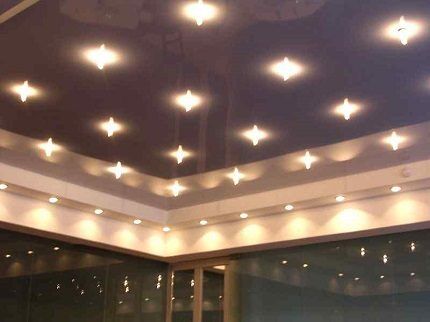
When purchasing, focus on power and heating temperature. Incandescent lamps are not suitable, so usually choose halogen appliances power 35–40 W or LED low voltage options.
In some cases - energy-saving fluorescent lamps up to 50 W. There are also certain requirements regarding the safe location of lighting fixtures.
Basic selection rules
Everything matters - type, shape, power, placement of lamps on the ceiling.
The main rules to follow when choosing:
- Type and power of lamps. The best option is 35-50 W lamps.
- Distance to ceiling. The critical minimum is 15-20 cm. If you place the lamps closer to the surface of the material, this will lead to its deformation. For incandescent lamps the distance should be even greater - from 40 cm.
- Shape of lamps. The beloved “plates” will have to be abandoned. The rules for their installation provide for a tight fit to the ceiling surface. In the case of tensile structures, this is unacceptable, because For cooling you need full air circulation.
- Design. It all depends on the personal preferences of the owner of the premises. It is important that the devices are installed in accordance with all the rules and provide adequate lighting.
The variety of lamps is enormous, so it makes sense to navigate the main classifications and find the option that is best suited for each specific case.
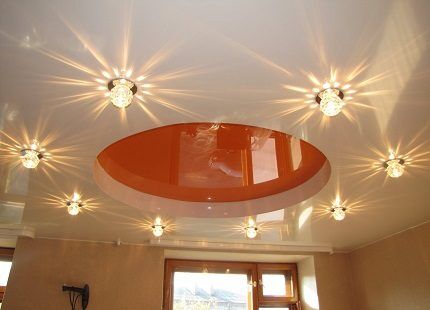
When purchasing, you should take into account the purpose and operating features of the premises, pay attention to the installation rules, degree of protection electrical appliances, color temperaturecharacteristic of energy-saving light bulbs.
Complex installation leads to an increase in the cost of lighting, often unjustified. The problem can be solved by choosing a different type of lamp.
Pros and cons of different types of light bulbs
Typically, one of three types of lamps are used for suspended ceilings:
Each of them has its own advantages, disadvantages, and limitations in operation. To make an informed choice, it is better to find out their features in advance.
Option #1 - LED lamps
These are semiconductor devices. They give white or slightly yellowish light and do not overheat the air or surrounding objects. One of the most important advantages is inertia-free. This means that the brightness of the lighting is adjusted immediately: there is no need to wait until the device “burns up” at full power. It is not affected by power surges in the network.
Moreover, there are models on sale whose brightness can be adjusted at the user’s request - dimmable LEDs. This option allows you to develop and use several original lighting options in one design.
All LED devices are classified as energy-saving lighting devices, because they consume 5-8 times less electricity than incandescent lamps. This is an obvious plus, but the price is still more than high.
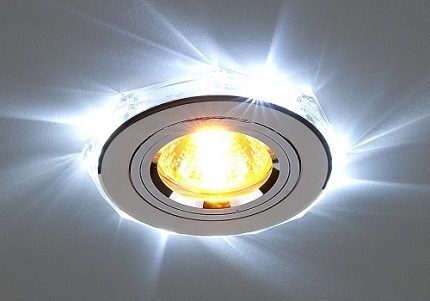
Noting the high cost of diode light bulbs, you should decide on the type of lamp itself at the lighting planning stage. If this is a model into which a matrix/board with LEDs is integrated, then if it fails, repair or replacement of the element may be necessary.
Not every ordinary user will bother buying a new board and replacing it themselves. And calling an electrician for this will be expensive - it’s easier to buy a new lighting fixture.
A more interesting alternative is to purchase a lamp in which you can change the bulb. There are various models on sale that accept lamps with a GU5.3 base. Will familiarize you with the rules for choosing lamps for ceiling structures next article, which we strongly recommend reading.
If such an LED light bulb fails, then you can simply remove the old one and install a new one, which costs about 60 rubles. And you don't have to buy the entire lamp. Due to the high cost of lamps from well-known brands, many potential buyers have a desire to save money by choosing cheaper products from nameless Chinese companies.
This benefit is highly questionable due to a number of features:
- price - a good diode light bulb cannot be cheap, and inexpensive ones most often do not have a manufacturer’s warranty;
- the service life does not always correspond to the declared one - only branded lamps are able to work out the operating hours declared by the manufacturer;
- decrease in brightness - LED crystals gradually lose their brightness, and then go out completely.
Also, before purchasing, you should pay attention to the color spectrum emitted by the selected LED lamp. In this matter, you should be careful and decide in advance whether such light is pleasant to the eyes.

When developing a ceiling design, be sure to carefully select the correct color of lighting, calculate the required power and cost of the devices. This is the only way to make the interior truly cozy and pleasant. If necessary, consult professional designers and electricians.
Option #2 - halogen lamps
The principle of operation is similar to the operation of conventional incandescent lamps, only a special grade of tungsten is used to make the wire filament. The only significant difference is in the filling of the flask, which contains oxygen, inert gas, and halogen-containing additives.
When heated, tungsten evaporates from the thin wire and then returns to it again. Thanks to this, a darkening coating does not appear on the flasks. The filament itself regenerates, which has a positive effect on the life of the lamp.
Tungsten wire heats up to high temperatures, but this is compensated by the use of special quartz glass, which retains heat and increases the efficiency of the device.
Lamps with halogens are distinguished by high quality color rendering, brightness, and light direction. Another plus is the small size. This allows you to design aesthetic spot lighting.
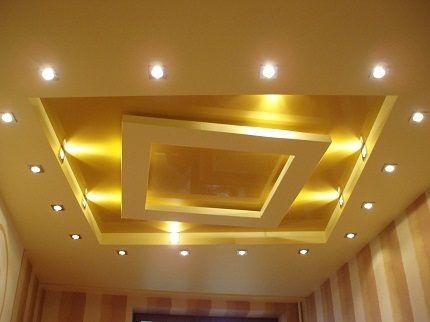
When it comes to energy saving, halogen lamps are inferior to LED and fluorescent lamps. The service life also leaves much to be desired. This should be taken into account when purchasing.
Option #3 - fluorescent lamps
They are deservedly called energy-saving. Whatever lamp is installed, with such devices it will automatically become economical. This is due to the design features, thanks to which you can get an excellent ratio of luminous flux and power.
Economical energy consumption, good operational and technical characteristics - these are the advantages of fluorescent lamps. They do not flicker, if we are talking about compact models with an integrated electronic ballast, they work for a long time and smoothly. You can choose a suitable color shade.
Another plus is the absence of overheating of the surrounding air and objects located near the lighting fixtures. Maximum temperature – 60 degrees.
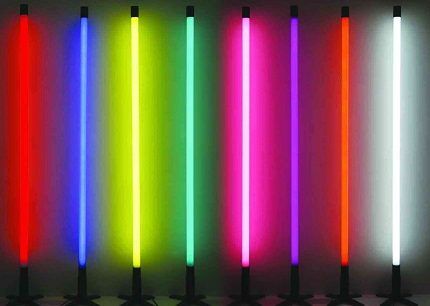
There are also disadvantages:
- Potential health hazard. It is harmful for people with certain diseases to be in rooms with fluorescent lighting.If you have serious diagnoses, you should consult your doctor.
- High price. Compared to incandescent lamps, fluorescent lamps are 10 times more expensive.
- Sensitivity to on-off switching. The more often appliances are lit and extinguished, the less they last.
- Harm to the environment. Lamps contain unsafe mercury vapor, so the devices require separate disposal. If a flask breaks, you need to thoroughly ventilate the room, collect the remaining glass and treat the room.
Before purchasing fluorescent lamps, be sure to make sure that your city has collection points for used products. They should not be thrown into a regular trash container.
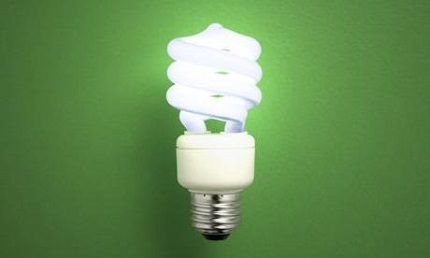
If several fluorescent lamps are broken at the same time, you will have to call the Ministry of Emergency Situations for preventive treatment of the room. This is worth considering, especially if there are small children, active jumping animals, etc. in the house.
Rules for connecting lamps
The type of luminaires in which the lamps are planned to be installed is of fundamental importance. There are different types of fastening structures.
Hanging. In everyday life they are called chandeliers. A win-win option for almost any interior.
You can mount lamps of all types, because... the distance to the ceiling is sufficient to avoid strong heating of materials. Installation is simple. Prices may vary depending on the model, manufacturer, design.
Invoices. For such structures, it is necessary to install a base with electrical wiring before installing the stretch ceiling.Then they put special rings in which the lamps are secured. LED lamps are best suited for them - with a minimum heating temperature. The advantages include the low cost of structures.
Built-in. The difference from overhead lamps is only in the installation method and the presence of a decorative panel, thanks to which the design of the device is almost indistinguishable from the surface of a stretch ceiling.
The advantage is the low cost of construction. Ideal for office spaces and minimalist interiors. Depending on the number of light sources, spot and cascade lamps are distinguished. In devices of the first type, only one lamp is installed, and in the second type, several are installed.
Point structures have to be installed in rows due to the modest lighting area. Cascading ones have extensive design potential. Thanks to them you can create beautiful effects.
There are static and rotating lamps. The names reflect the design features: the first ones are stationary, and the second ones allow you to adjust the direction of radiation.
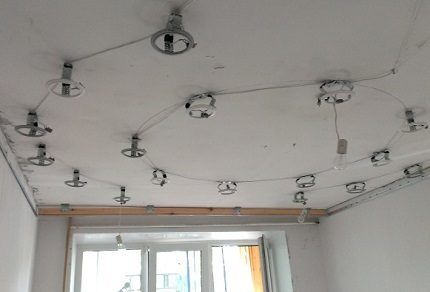
The type of material from which the ceiling panel itself is made also matters. If it is fabric, then the choice of lamps is almost unlimited, but it is better to install LED devices on PVC film.
Requirements for placing lamps on the ceiling
When designing lighting, several simple rules are followed:
- The first row of lamps is planned so that it is at least 20 cm from the wall.
- If there is only one pendant lamp, it is installed in the center of the ceiling.
- Seams are the weak points of PVC structures.There should be no light sources at a distance of less than 15-20 cm from them.
- When calculating lamps, you can focus on average indicators: 1 device per 1.5-2 sq. m. area. If it is necessary to provide powerful lighting, then proceed from the first number. If special brightness is not needed, use the second one.
- With a symmetrical arrangement of lamps, the distances between them and the distances from the wall are taken into account.
Windows are sources of natural sunlight. When calculating the layout of light bulbs, they must be taken into account, but there are no special requirements here. The main thing is to maintain a distance from the walls.
Light source layouts
There are several design ideas that allow you to place appliances in the most advantageous way. Before you independently invent new ways of arranging lamps, you should familiarize yourself with the existing ones.
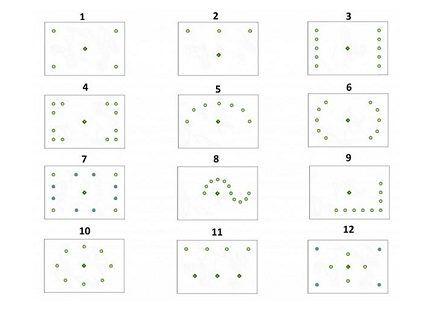
The most popular layouts of light bulbs on a suspended ceiling include the following:
- Oval. Lighting fixtures are placed in the form of an oval inscribed in the rectangle of the ceiling. The center is either decorated with a chandelier or left slightly darkened.
- Circle. The lamps look like a big circle on the ceiling. The advantage of this scheme is uniform illumination of the entire area.
- Rectangle. The devices are installed around the perimeter, which creates an optical effect of expanding the space.
- Arc. An excellent option for highlighting an accent area of a room.
- Wave. The arrangement of lamps in the form of a wave is well suited for rooms of non-standard configuration.This scheme allows you to visually adjust the shape of the room.
In rooms with niches, ledges or original furniture, random patterns can look good. Often the lamps look chaotically located, but create the necessary effects.
If you decide to design the ceiling this way, you need to carefully calculate the required number of light sources. The choice of scheme may depend on the purpose of the room and the personal preferences of the owner.
There are no ideal lamp layouts that would suit everyone equally. The lighting design of each room must be approached individually.
But there are general recommendations that will help you make your choice.
Conclusions and useful video on the topic
Selecting and arranging lamps is a difficult task, but it can be overcome if you follow the recommendations of experienced designers. We offer a selection of thematic videos that will help with this.
Video #1. Unobvious pros and cons of different types of lamps:
Video #2. Calculation of the number of lamps:
Video #3. Detailed description of lamp layouts:
Video #4. Options for selecting lamps for suspended ceilings:
Successful lighting effects can transform even the most banal interior, while incorrectly selected lighting effects will negate all design efforts.
Stretch ceilings are a good solution if you take the time to search for suitable lamps and calculate the optimal layout for their placement. If you can’t do it yourself, don’t hesitate to consult an electrician.
Please write comments in the block form below, post photos and ask questions about the topic of the article. Tell us about how you selected light bulbs for your own suspended ceiling. Share useful information and arguments that were decisive for making your purchase.




I made suspended ceilings in the apartment during renovation. And then questions arose regarding the installation of lighting: what is the best way to install a chandelier, what lamps to install? I was worried that the structure might deform and break due to heat. In the end, I settled on LED lamps, since they fit into the interior and did not depend on power surges. Plus, the bonus of such lamps is energy saving, which means that I pay less for electricity.
The best of all are LED! Today they are used everywhere! I personally am not surprised that these lamps have such a price. After all, they last a long time and consume much less electricity than other types of lamps. LEDs are now everywhere - there are floodlights with moisture protection that can be installed outdoors, there are lights for rooms and equipment, and, of course, light bulbs. LEDs are the future!